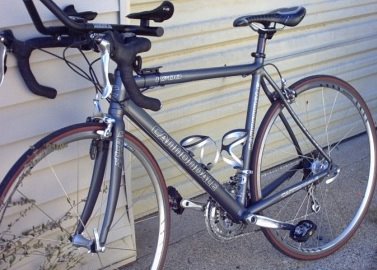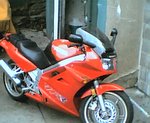
Bicycle Safety-common ways Bicyclists are hit, and how to avoid them~
Collision Type #1:
The Right Cross
This is one of the most common ways to get hit (or almost get hit). A car is pulling out of a side street, parking lot, or driveway on the right. Notice that there are actually two possible kinds of collisions here: Either you're in front of the car and the car hits you, or the car pulls out in front of you and you slam into it.
How to avoid this collision:
1. Get a headlight. If you're riding at night, you should absolutely use a front headlight. It's required by law, anyway. Even for daytime riding, a bright white light that has a flashing mode can make you more visible to motorists who might otherwise Right Cross you. Look for the new LED headlights which last ten times as long on a set of batteries as old-style lights.
2. Honk. Get a loud horn and USE IT whenever you see a car approaching (or waiting) ahead of you and to the right. If you don't have a horn, then yell "Hey!" You may feel awkward honking or yelling, but it's better to be embarrassed than to get hit. Incidentally, the UK requires bells on bicycles.
3. Slow down. If you can't make eye contact with the driver (especially at night), slow down so much that you're able to completely stop if you have to. Sure, it's inconvenient, but it beats getting hit. Doing this has saved my life on too many occasions to count.
4. Ride further left. Notice the two blue lines "A" and "B" in the diagram. You're probably used to riding in "A", very close to the curb, because you're worried about being hit from behind. But take a look at the car. When that motorist is looking down the road for traffic, he's not looking in the bike lane or the area closest to the curb; he's looking in the MIDDLE of the lane, for other cars. The farther left you are (such as in "B"), the more likely the driver will see you. There's an added bonus here: if the motorist doesn't see you and starts pulling out, you may be able to go even FARTHER left, or may be able to speed up and get out of the way before impact, or roll onto their hood as they slam on their brakes. In short, it gives you some options. Because if you stay all the way to the right and they pull out, your only "option" may be to run right into the driver's side door. Using this method has saved me on three occasions in which a motorist ran into me and I wasn't hurt, and in which I definitely would have slammed into the driver's side door had I not moved left.
Of course, there's a tradeoff. Riding to the far right makes you invisible to the motorists ahead of you at intersections, but riding to the left makes you more vulnerable to the cars behind you. Your actual lane position may vary depending on how wide the street is, how many cars there are, how fast and how close they pass you, and how far you are from the next intersection. On fast roadways with few cross streets, you'll ride farther to the right, and on slow roads with many cross streets, you'll ride farther left.




No comments:
Post a Comment